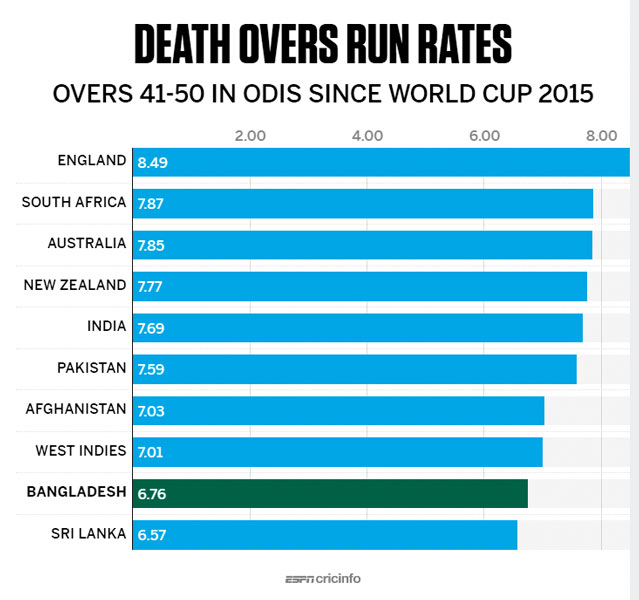BIRMINGHAM, June 28 (ESPNcricinfo): There and thereabouts, but not quite in the top four for the most part of the World Cup, Bangladesh have managed to keep their campaign relevant leading up to their long break in Birmingham.
They remain a semi-final contender by being fifth on the points table, and by the time they play their next game against India, on July 02, they will have a clearer picture of their task ahead. What makes their campaign impressive is how they have managed so much despite their limitations.
 They won convincingly against Afghanistan but weren't ruthless enough to press the accelerator while batting in the last 20 overs. They finished on 262 but Shakib Al Hasan later said that their initial target was to score 240 since they didn't believe the pitch was conducive for a bigger score. But, even on batting-friendly pitches, they have not scored fast enough.
They won convincingly against Afghanistan but weren't ruthless enough to press the accelerator while batting in the last 20 overs. They finished on 262 but Shakib Al Hasan later said that their initial target was to score 240 since they didn't believe the pitch was conducive for a bigger score. But, even on batting-friendly pitches, they have not scored fast enough.
England, who have scored at 7.26 per over in this phase since the new Powerplay rules were changed in July 2015, have made a name for themselves simply by being the fastest scoring team. India, Australia, Pakistan, South Africa and New Zealand have all struck at around 6.50 per over during these 20 overs, but Bangladesh lag behind at 5.88.
Between the 2015 and 2019 World Cups, all teams playing in this edition, except West Indies and Afghanistan, have scored at around five an over in the first 30 overs. England, who began their ODI scoring rates revolution during this period, are on top with a scoring rate of 5.76 but it is in the last two overs where they leave everyone miles behind, scoring at 8.49 per over.
While Bangladesh keep themselves abreast of the scoring rate in the first 30 overs (5.09, above Sri Lanka and Pakistan), they are way behind most sides in both the last 20 overs (5.96), as well as the last ten overs (6.76) of their innings.
Stronger teams often promote a big hitter after 30 overs to push the throttle before the 40th over because one extra fielder is allowed outside the 30-yard circle in the last ten overs, when the bowlers also try to bowl yorkers once the ball gets softer.
Bangladesh haven't done this because they rely heavily on the set batsman at the crease during the latter stages of the innings, which means that they cannot start hitting out until late if wickets fall suddenly.
Until their match against Afghanistan on Monday, Mahmudullah had faced the second-most deliveries from overs 31 to 40 in this World Cup, but with a strike rate of 74, the fourth-lowest among those who have faced at least 40 balls in that phase.
For comparison, Jos Buttler has scored at 140 in that period, Usman Khawaja at 118 and Sarfaraz Ahmed at 93.52, among others who are above Mahmudullah.
In the last ten overs, Mahmudullah has been striking at 144 this World Cup, which is much more promising and only below big-hitters like Buttler, Hardik Pandya and Eoin Morgan, who have faced at least 40 deliveries in this phase. Mahmudullah has been given this role since 2016, and he has made a significant shift from his previous role of a lower middle-order batsman.
He has raised his strike rate, but he doesn't quite have the support of a Hardik, Andre Russell or Carlos Brathwaite to push the run rate in the slog overs.
Mosaddek Hossain scored a 27-ball 52* in the tri-series final Getty Images
Only once in the last 12 months have Bangladesh promoted a slogger with 12 overs remaining. Surprisingly, it was Mashrafe Mortaza promoting himself against West Indies during the third ODI in St Kitts last year, and it worked brilliantly for them. He struck 36 off 25 balls, and what was looking like a middling 260-odd total turned into 301 for 6, and Bangladesh went on to win the game by 18 runs.